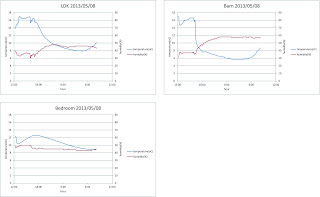The five members in Hokkaido are now working on the design of the charcoal shelves on the south side of the Barn House.
Below are studies and the best design will be built during the summer.
(現在バーンハウス南面の炭棚をつけたファサードデザインをやっています。以下はスタディーで、最も良いと思った案を夏までに完成させて着工したいです。)
We have also asked Takahashi construction firm to give an estimate of how much the shelves will cost.
We are currently waiting for their reply.
(炭棚の設計に際して、高橋工務店の方々に見積もりを依頼しました。)
We are happy to find that the temperature of the compost is rising daily. From this we can tell that the compost is decomposing.
However,
we have been disappointed to find that the temperature of the
living/dining/kitchen has not been affected by the heat of the compost.
(堆肥発酵熱の実験の法は順調で、堆肥の温度が日に日に上昇しています。しかしまだリビングを温めるほどの熱量はなく、グラフにも表れていません。)
On May 9th, we visited Handa Farm in Taiki-cho. Here we got to touch donkeys,
goats, and dogs. We also ate the fresh ice cream and pizza made at the
farm.
They were very delicious.
(また5月9日に大樹町の半田ファームに訪れました。ロバやヤギや犬などの動物と触れ合ったり、おいしいソフトクリームを食べてリフレッシュしました。)
The detail of experiments and facade design update soon !
(実験の詳細や、ファサードデザインのことは随時更新していきます。)
Saturday 11 May 2013
Wednesday 8 May 2013
On May 6th, co+labo began the first of four intensive seasonal data collection and observation sessions of the Barn House project at Meme Meadows Taiki-cho Hokkaido.
(5月6日から北海道大樹町のメムメドウズにおけるバーンハウスプロジェクトの第一回目の研究活動を開始しました。年間4つの季節を通して、温熱環境の測定実験などをやっていきます。)
For this spring session, Yoshihiro Sasamura, Ken Akatsuka, Yoshiaki Kato, Kira Horie, and Sotaro Miyatake have come to Hokkaido. We were surprised to see it was still snowing when we arrived at Obihiro Airport.
(今回の訪問では、笹村佳央、赤塚健、加藤良章、堀江季良、宮武壮太郎の5人が北海道に訪問しています。帯広では5月なのに雪が積もっており、驚きました。)
Here is what we have been doing since arriving in Hokkaido:
May 7th (Tuesday)
We took out the decomposed horse manure from the compost room. It was pretty tough.
(5月7日、私たちは、バーンハウスの堆肥室に詰めてあった堆肥化してしまっている馬糞を取り除くことから始めました。この作業は1日かかり、とても体力を使う作業でした。)
Here is the picture of the compost room after we finished taking everything out:
May 8th (Wednesday)
We brought in new, undecomposed horse manure to the compost room. The heat that is created in the process of decomposition will help keep the Barn House warm.
(5月8日、私たちは、新しい馬糞を堆肥室に詰めなおしました。馬糞の堆肥化によって得られる熱量を測定していく準備が整いました。)
Here is the picture of the compost room after we finished putting in new horse manure:
We also began taking recording the temperatures of four different locations inside the Barn House.
(早速温度計を設置し、各部屋の放射熱や堆肥熱を測定開始しました。)
Here are the temperature results from May 8th.
We are looking forward to seeing the results after we have finished taking temperature data for an entire year.
(この実験結果が年間を通じてどう変化していくか、また有効な熱源となるのか、結果がとても楽しみです。)
We have also begun preparations for adding shelves to place charcoal on the south side of the Barn House. We took photographs and took measurements of the south side.
(私たちはまた、家の南面に臭い吸着のための炭を保管しておくための炭棚の設置を試みています。只今炭棚のデザイン中です。)
We are looking forward to interviewing the local people about the Barn House and working to help further improve the Barn House.
(また、バーンハウスがメムメドウズに、大樹町に、北海道にどのような影響を与えるのか、アンケートやインタビューを行い、その結果を反映し、さらに良い住宅を作り上げていきたいと思っています。)
Saturday 4 May 2013
06 MAY 2013 co+labo team leaves for Hokkaido
the task of the team is to set up the co+labo research project at the Meme Meadows Barn House
co+labo Hokkaido project
fieldwork plan
Research leader: Darko Radović
Research design: Darko Radović, Saikawa Takumi, Komatsu Katsuhito+LIXIL,
KKAA
Research coordination: Sasamura Yoshihiro
In 2013, Meme Meadows in Hokkaido will be the site of a major
Mn’M +H project. The project includes:
-
post-occupancy evaluation
of the Barn House (including measurement, data collection, observation)
-
development of design
ideas for introduction of charcoal and completion of the building
-
design suggestions for
further improvements of the Barn House itself and the Meme Meadows site
The Barn House research will be conducted in four intensive
seasonal data collection and observation sessions,
1
spring session: 6-19 May (to be coordinated with the Harvard
team visit to Hokkaido 15-16 May)
team for spring
session: Sasamura, Akatsuka, Kato, Horie, Miyatake (week-by-week staffing
t.b.c)
2
summer session: … August (during the Keio summer vacation)
3
autumn session: …
November (coordinated with the Harvard project completion ceremony)
4
winter session: … January or February (during the Keio winter
vacation)
DR will try to
participate in at least 3 sessions.
Draft agenda
This
agenda sets the basic details for the Barn House fieldwork spring session, and
defines minimal work and outcomes. The fieldwork team will also recommend the
improvement of the agenda for the forthcoming, summer session.
All
observations and data will be multiscale – focusing at interactive scales of
Taiki-cho, Meme Meadows, the Barn House paddock and the Barn House itself (spaces
for humans, spaces for horses, interactions between them). A special emphasis
will be at inside-outside, and spaces for humans - spaces for horses interface.
Detailed composition,
agenda, work-plan, individual contributions and lengths of stay for each
fieldwork team will be decided in advance. The team will organize and conduct structured video
and audio-recordings.
Subscribe to:
Posts (Atom)























